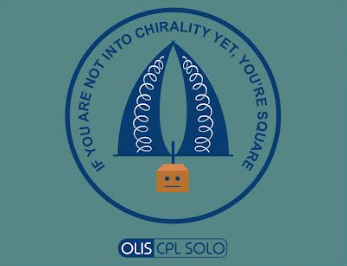
OLIS DSM 172 UV/Vis/NIR
Tool-free modularity for CD and CPL, and more
This uniquely versatile CD employs a prism-grating monochromator for 185-2600 nm throughput, plus an emission channel (you choose UV/Vis or NIR), and the Polarization Toolbox sample compartment.
Absorbance and CD to 1700 nm. Circularly polarized luminescence, fluorescence, and anisotropy emission 230-870 nm (extendable to NIR) and excitation 185-2600 nm.
To transition from 180 degree measurements – CD and absorbance – to 90 degree measurements – CPL & fluorescence, open the appropriate software icon and position the polarizer(s) and modulator before the sample (CD) or after the sample (CPL).
The right answer is the only answer a DSM CD can return.
Standard Model Performance
Circular Dichroism
Circularly Polarized Luminescence
Absorbance
Fluorescence
Anisotropy
Accessories
Download Specifications
Why Choose the OLIS DSM 172?
#1
You need both UV/Vis NIR CD and UV/Vis (or NIR) CPL, plus more!
#2
You might also want 185-2600 nm absorbance and/ or fluorescence
#3
You love modular, reliable, accessible equipment
Ask for a price quote today!

"Even more, we can measure CPL signals of racemic samples irradiating only one enantiomer and evaluate the optical properties of one enantiomer even when the other one is placed into the sample. We are able to obtain GLUM values up to 0.0001."
Showing the incorporation of a third party cryogenic flask within the OLIS Polarization Toolbox
OLIS DSM 172 : The ultimate example of an ‘endlessly upgradeable spectrophotometer’ is the Cary 14 utilized in the OLIS DSM 172. The world-class prism-grating monochromator and battleship stalwart chassis are upgraded with a xenon arc light source and the CPL Solo, creating the world’s only UV/Vis/NIR CD and UV/Vis (or NIR) CPL, while retaining the original 185-2600 nm dual beam absorbance potential. Upgrade with accessories for temperature control, thin film variable angle measurements, magnetic field, excitation polarization, and more.
Like all OLIS products, the name for this model was coined when we first conceived of its configuration. The “17” comes from the Cary 17; the “2” was added to remind us that there is a second monochromator, now an OLIS single grating model for emission. “DSM” is the elegant and digital data acquisition method common to all OLIS products with a PEM or quarter wave plate, i.e., all CD and CPLs. The first DSM 172 models are three generations of electronics and computerization behind today’s Win 10 models, but they can be upcycled to be identical to what we are producing today.
We are so proud to incorporate classic Cary 14 and Cary 17 Uv/Vis/NIR prism-grating monochromators into all OLIS systems with “14” or “17” in their name, e.g., the OLIS DSM 172. We are only utilizing the monochromator and chassis from the original, but both are of such outstanding quality that nothing “new” surpasses them for optical excellence and stalwart construction. All resulting OLIS systems employ 100% new OLIS electro-mechanical components and computerization. Click on this image for an informative four-page document.
Technologically superior, less expensive, and smaller NIR CD & CPL.
Comparing CPL’s by OLIS, Jasco, Applied Photophysics, and Edinburgh Instruments
DSM 172 Resources
Five CPL publications in 2018 from the laboratory of Araceli Campaña at the University of Granada:
Pyrene-Containing ortho-Oligo(phenylene)ethynylene Foldamer as Ratiometric Probe Based on Circularly Polarized Luminescence
Minh H. Nguyen, Masashi Imanishi, Taichi Kurogi, Xuemei Wan, Jane E. Ishmael, Kerry L. McPhail, and Amos B. Smith III
The Journal of Organic Chemistry 2018, 83, 8, 4287-4306
Enantiopure distorted ribbon-shaped nanographene combining two-photon absorption-based upconversion and circularly polarized luminescence
Carlos M. Cruz, Irene R. Márquez, Inês F. A. Mariz, Victor Blanco, Carlos Sánchez-Sánchez, Jesús M. Sobrado, José A. Martín-Gago, Juan M. Cuerva, Ermelinda Maçôas, and Araceli G. Campaña
Chem. Sci., 2018,9, 3917-3924
Undecabenzo[7]superhelicene: A Helical Nanographene Ribbon as a Circularly Polarized Luminescence Emitter
Carlos M. Cruz, Dr. Silvia Castro‐Fernández, Dr. Ermelinda Maçôas, Prof. Juan M. Cuerva, Dr. Araceli G. Campaña
Volume57, Issue45, November 5, 2018, Pages 14782-14786
OFF/ON switching of circularly polarized luminescence by oxophilic interaction of homochiral sulfoxide-containing o-OPEs with metal cations
Pablo Reiné, Ana M. Ortuño, Sandra Resa, Luis Álvarez de Cienfuegos, Victor Blanco, M. José Ruedas-Rama, Giuseppe Mazzeo, Sergio Abbate, Andrea Lucotti, Matteo Tommasini, Santiago Guisán-Ceinos, Maria Ribagorda, Araceli G. Campaña, Antonio Mota, Giovanna Longhi, Delia Miguel and Juan M. Cuerva
Chem. Commun., 2018,54, 13985-13988
Circularly Polarized Luminescence of Boronic Acid-Derived Salicylidenehydrazone Complexes Containing Chiral Boron as Stereogenic Unit
Vicente G. Jiménez, Fábio M. F. Santos, Silvia Castro-Fernández, Juan M. Cuerva, Pedro M. P. Gois, Uwe Pischel, and Araceli G. Campaña
J. Org. Chem. 2018, 83, 22, 14057–14062
OLIS SpectralWorks screenshot
VIDEO: Circularly Polarized Luminescence (CPL) with OLIS DSM 172
CPL being done with xenon arc lamp through the Cary 17 prism-grating monochromator with the OLIS Polarization Toolbox, single grating emission mono and photon counter. Dr. Richard DeSa and Prof Jeff Petty at Furman University. These measurements were followed by the identical measurement using a wavelength appropriate LED as the exciting source
VIDEO: OLIS DSM 172 for CD, CPL, Pol of Fluo, and UV/Vis/NIR Absorbance
















